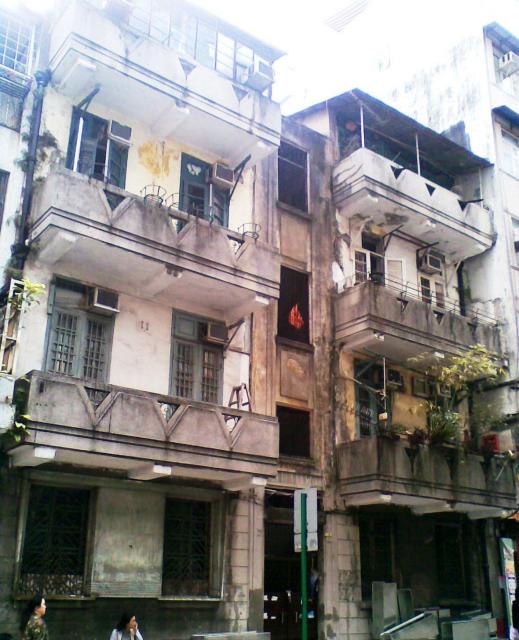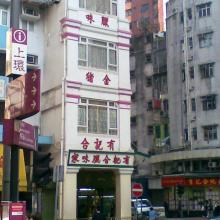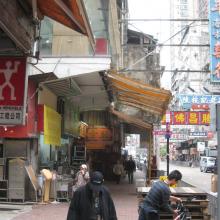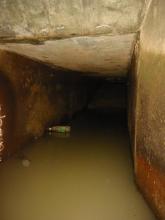I don't believe this one is on the Batgung website so I am not sure if it qualifies as a shophouse. May be Readers T and Phil can assess that.
Get Gwulo's books
Directory
Click on your area of interest to choose from over 30,000 pages about old Hong Kong:
- Images & photos
- View - View galleries - View new - Create - Forum topics
- View - Create - Places & buildings
- View map - View new - Create - Streets
- View map - View new - Create - People
- View - View new - Create - Organisations
- View all - View new - Create - Diaries & memoirs
- View - View new - Create diary - Create page - Events
- View - View new - Create - Jurors lists
- View - Type a page
Or choose a popular article:





Comments
Shophouse or not?
Sophia, thanks for posting.
I read once that if the balcony is built like this without any supporting pillars, then it is a sign that the building was built after the war. Can anyone confirm?
Tenant Houses
Hi there,
I believe they are called Tenant Houses. Some are pre-WWII.
Best Regards,
T
Re-Happy Valley
Happy Valley tenements
Tenant Houses
Hi T,
Please can you describe any common features that mark a building as a Tenant House? It's a new description for me, so I'm interested to know when we should use it.
Cheers, MrB
Tenant Houses
Hi there,
I guess we could just take it literally. A tenant house is primarily for dwelling and is usually within City districts where Shop Houses would at least have the Ground floor primarily associated with trade. There are exceptions like those old pawn shops or traditional Cantonese Restaurants that take up the whole block.
If I am not mistaken both the terms Tenant House and Shop House had appeared in Government documents.
It is sort of confusing when labelling is in place. Actually the Cantonese use of 唐樓 Tong Lau fits them all. We only have a few distinctions over this, say, wooden ones (with wooden stairs and floors), pre-war (pre-WWII). The rest within this category are all just being called Tong Lau.
The Chinese philosophy don't usually define to the exact and to the extreme in most occasions. If you have learnt some Chinese words, you might probably know one word could have many meanings. Sometime it could be a verb and at the same time it could also be a noun. And the Chinese language don't have tenses. At least not in the sense of past/present/future tenses as in English. Hmmmm, sorry, I got carried away.
T
Tenant or Tenement
English as a second language
Hi there,
I guess I have to look it up some how. These are the problems that have to face very often. My vacabulary is just mediocre. Anyway "Tenement" does suit in most cases. I'll try to see if I could locate the Government document online and see what they used. I believe those documents dealing of city planning and re-development might just have these terms in them.
Best Regards,
T
language
Don't worry T, I wasn't trying to be critical. My post was spurred by MrB's question as to what a Tenant house was, I assumed he was thinking it was a different beast altogether.
Phil
Had a closer look at this
Hi: Do you guys have any idea
Hi:
Do you guys have any idea when the term 'art deco' was first used in Hong Kong to describe buildings?
Since there are a few descriptions of buildings in the site using that term, I'm curious if anyone knows exactly who (architects/ commentators/media) started identifying with this style in the first place.
Same style - one is just dirty
The balconies are the same - see the v shaped holes? The one on the right is just dirty.
demolished
this building's gone now, they knocked it down a couple of months ago. apparently there was some dispute over ownership that kept it empty for years
Was this 17 and 19 Yik Yam Street?
If that's what is in your picture, then here is the relevant court judgment:
http://legalref.judiciary.gov.hk/lrs/common/ju/ju_frame.jsp?DIS=22500
Squatters take over
The squatter took "adverse possession" for 20 years - so the building is now theirs !
squatters rights
this is the same law that exists in the UK - except the time frame there is only 12 years.
There was an incident about 10 years ago in London when a 5 storey townhouse in Kensington was given over to the squatter who had occupied it, unopposed, for 12 years.